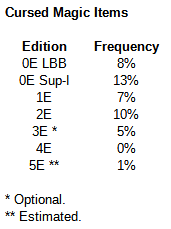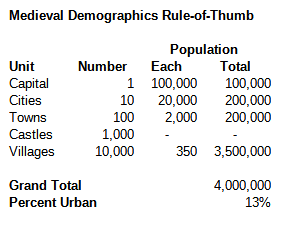For quite some time, it's been left as ambiguous in my OED House Rules whether or not fighters get "sweep" attacks -- the hyper-accelerated mode where they take as many attacks per round as they have levels, but only against low-level (1 hit die) creatures.
One of the major themes for this year, both on my blog here (and here) and in discussions on the Wandering DMs YouTube channel, is my finally becoming convinced that (a) that rule really was intended consistently throughout Gygax's Chainmail, OD&D, and AD&D, (b) it's a critical aspect to balancing against the large mobs of 1-HD humanoids who appear in groups of hundreds, and (c) it's the single biggest rules difference between the O/AD&D lines and the Basic D&D lines (where the rule is removed, and humanoid numbers greatly reduced).
So granted that, I think I need to make an explicit call about whether that's a base assumption for OED, and in my next update, in line with the classic game, I'll be highlighting that as an included rule. (And also removing "cleave" from the list of optional feats, but then I never saw a player pick that anyway, so it's a minor issue.)
In some ways it's actually not my favorite rule; I'm less than thrilled with the discontinuity between 1 and 2 HD, and the possibility of a large number of dice being rolled. But the advantages of recognizing it include: (a) closer compatibility with the original game, (b) recreation of inspirational pulp stories (where heroes like Conan indeed hold off huge mobs), (c) some way for fighters to hold pace with high-level wizards, (d) less modification needed vs. reducing all the humanoid numbers appearing, and (e) a mechanic that legitimately makes high-level fighters significant in mass combat, such as Book of War.
(And I'm less bothered by the OD&D FAQ/Swords & Spells presentation of, "base 1 hit die or less", versus the AD&D version of strictly "less than one hit die", which made the switchover difference a single hit point, e.g., leaving goblins in but taking orcs out.)
If a DM looks at OED and wants to snip out the sweep attack rule (and commit to changing monster numbers appearing), then that's fine and respectable -- and I think easier than if I left it out and another DM needed to add it back to the system. There were some other alternatives that I considered and tested along the way (like a generalized "cleave" rule, or changing every single monster number in the game), but I wound up rejecting those, so I won't go into them here.
Here are some other observations on the effect of sweep attacks, based on recent investigations.
Arena Simulator
Recently I modified the code in the Arena Simulator on Github to add an optional switch to turn on sweep attacks (-w). What we see is that on average, the power value of the 1-HD monster types gets cut down to about one-quarter basis. This is summarized in the following table; here, EHD is "Equivalent Hit Dice"; the average number of fighter-class hit dice the monster can evenly match up against.
Normally the EHD calculation seems fairly robust to me, because it's an average over what I call the EFHD value (Equivalent Fighter Hit Dice) at each fighter level, and that latter number tends to be roughly constant over different levels for standard monster types (at least within a factor of about 2 or so). Some exceptions stand out for monsters with big area attacks or high hit-by magic (kill lots of low-level fighters, generating a right-skewed EFHD distribution), or ones with potent save-or-die effects (more easily wipe out high-level fighters' hit dice, giving a left-skewed EFHD distribution).
And now, monsters subject to sweep attacks present another outlier case, because the lethality of the fighter-types suddenly varies so much by level, due to their many-multiplied attacks. (Normally fighter stamina is increasing by level, while attacks stay about the same; in this case fighters become quadratic, too.)
So let's look at that a little more closely. The interesting thing is that sweep attacks actually change the EFHD curve slope from positive to negative. For example, here's a listing of the EFHD values for an orc, matched against fighter levels 1 to 12, with sweep attacks on, from the Arena simulator (-e and -w switches):
[1.0, 0.67, 0.6, 0.5, 0.42, 0.35, 0.29, 0.25, 0.2, 0.18, 0.16, 0.14]
As expected, the value of the orc decreases from EFHD 1.0 at 1st level (indicating that a 1st level fighter can hold off 1 orc), to EFHD 0.14 at 12th level (indicating that a 12th level fighter can fight off about 12 / 0.14 = 85 orcs). Now, what might be more surprising is the EFHD curve for an orc before the sweep attacks get turned on as shown here (using just the -e switch):
[0.5, 1.0, 1.0, 1.0, 1.0, 1.2, 1.17, 1.14, 1.13, 1.25, 1.22, 1.2]
What that shows is that the pro-rated strength of an orc (or other basic monster type) is normally increasing somewhat versus fighter level; e,g., from 1.0 at 2nd level to 1.25 at 10th level or so. It may be easy to overlook, but that's not really a mystery: we've long identified that as the effect of the Packing Problem, in that mobs of low-hit creatures are effectively sponging up more wasted overkill damage, whereas high-hit figures are suffering full damage from every hit but the last.
The effect of sweeping is so powerful that I had to increase the MAX_ENEMIES
cap in the simulator from the previous 64 to 256. (E.g.: a single
sweeping 12th-level fighter can hold his own against some 80 orcs as above, 160
kobolds, or 240 rats). This had a side effect for certain powerful monsters that are only hit by higher-powered magic items, like elementals (+2 to hit) and golems (+2 for stone, +3 for iron). Granted that no low-level fighters can possibly have such magic weapons in the simulator, those monsters effectively stomp an infinite number of normal men. And when the MAX_ENEMIES number goes up, then their computed EHD goes up. So that will be reflected in the next OED Monster Database update. Iron Golems are now assessed at EHD 125!
On the other hand, I don't intend to change the EHDs listed for the 1-HD types (mostly EHD 1), because: (a) I don't want to deal with fractions there, (b) I don't want to trick anyone into throwing 4 orcs at every 1st-level fighter, (c) as noted, the averaging process is a bit cracked in this outlier case, and (d) maybe some DMs won't be using sweep attacks in the first place.
Experience Awards
Classic versions of the O/AD&D game generally have a rule for pro-rating experience in the downward direction; that is, awarding only a fraction of the experience based on monster or dungeon level divided by character level. (E.g., from OD&D Vol-1, p. 18: "Gains in experience points will be relative; thus an 8th level Magic-User operating on the 5th dungeon level would be awarded 5/8 experience."). Personally, I hate this rule, most people I know ignore it, it creates unsolved problems with multi-character parties at different levels, etc.
Generally speaking, I don't think that rule makes any sense when the XP leveling tables are already themselves designed on a geometrically-increasing basis. Assuming we think of XP awards as generally balanced to the danger of the encounter, as noted above, we find that EFHD values are usually about constant across levels -- or in other words, danger is really linear in standard hit dice. The takeaway is that XP as a constant multiplier by HD (say 100 points per HD), and without taking a ratio for PC levels, is not a ridiculous thing to do.
But in the particular case of sweep attacks, that's certainly not true; the relative danger levels posed by goblins and orcs in the face of Superhero Cuisinart attacks indeed drop like so many carrot peelings. So for the first time ever, I could see the twinkling of an argument for reduced XP by a ratio of levels -- if one were focused specifically on the Hero-vs-mooks case as a default D&D fight, then the ratio-reduction is in fact legitimate.
I still don't think I'll use that rule in the general case, but I could start to imagine engaging it, specifically in the unique case of PCs versus armies of 1-HD humanoids who are getting mowed down for pulp narrative purposes.
And we're not quite done with the issue yet: next time, we'll revisit the OD&D wilderness encounter tables in the context of the sweep attack mechanic.
Do you use sweep attacks in your OD&D-flavored games? Or if not, do you drastically reduce the humanoid numbers appearing? And do you use the XP ratio-reduction rule, maybe just in this one special case?








